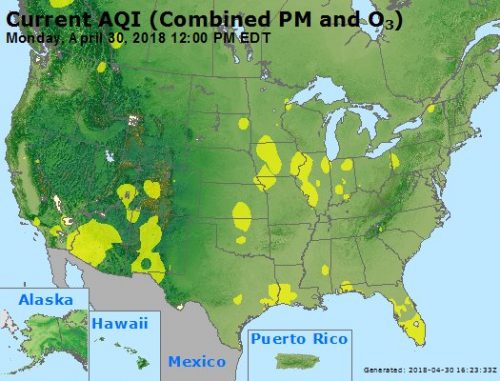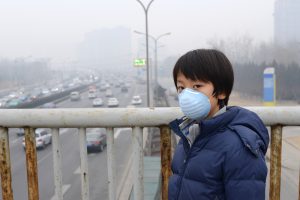By the Vital Strategies Environmental Health Division.
April 2018 marks the 20th anniversary of AirNow – a flagship program of the US Environmental Protection Agency (EPA) designed to help communicate information on local air quality within the United States. Every day, using an easy to interpret indicator called the Air Quality Index, AirNow informs the public about local air quality, and provides guidance on when they should take short-term, precautionary steps to protect their health.

The AirNow map shows live air pollution levels across the USA
Since the launch of AirNow, there have been concerted efforts to increase the availability, accessibility, and transparency of air quality data. For example, AirNow International provides real time air quality data from countries around the world. This data can be used by local governments to increase public awareness and provide guidance on how to protect vulnerable populations such as young children, the immunocompromised, and the elderly from air pollution episodes. Another platform that provides access to open source air quality data is OpenAQ, which provides tools to enable the expanded use of available data for education, research, policy, and advocacy purposes.
Since pollution does not respect administrative boundaries, in many cities and regions, the leading sources of pollution are from surrounding areas. For example, fire-related pollution, whether from agricultural burning, wildfires, or intentional burning of peatland forests, can be a leading seasonal source of pollution in South Asia, the western United States, and Southeast Asia respectively. Thus, beyond routinely collected information on levels and trends in pollution, analyses of the leading sources of pollution can be used to ensure that actions address the relevant culprits.

Air pollution in Singapore caused by fires burning in Indonesia
Thanks to the availability of air quality monitoring data and recent advances in using satellite-based sensors to measure air pollution, researchers have been able to assess air quality to quantify the global health harms from air pollution exposure. Robust evidence demonstrates that air pollution is a leading risk factor for global health, responsible for 6.1 million deaths each year. While there is not a country on earth without air pollution, levels of exposure to air pollution, and the resulting health impacts of exposure, are not evenly distributed. China and India bear a disproportion share of the global burden, as do many low- and middle-income countries. State of Global Air provides detailed estimates of national and regional trends in air quality exposures and health effects. These impact assessments, based on modeled estimates of exposure, can increase demand for action on air quality.

China and India bear a disproportion share of the burden of air pollution
At the same time, local action demands local data. Though it may not be possible in the short term to reproduce results of health studies conducted elsewhere, the availability of local air quality data may be used to bridge the gap between local air quality and the broader global health evidence base. There has been significant momentum toward increasing routine air quality monitors around the world, but the largest gaps continue to be in Southeast Asia and Africa, where available evidence suggests the number of people exposed to health damaging levels of air pollution are large and rising.
Routinely collected data on air quality, sources, and trends also enables us to evaluate the impact and success of measures taken to improve air quality. For example, in the United States, starting in the 1970s with the revision of the Clean Air Act, a number of drastic control measures were taken to improve air quality. The availability of routinely collected air quality data from over 500 counties across the country enabled a careful assessment demonstrating that reductions in particulate matter less than 2.5 microns in diameter (PM 2.5) increased life expectancy over an extended period. In addition, researchers have evaluated the effect of local actions on air quality and health, including the London congestion pricing scheme, the Dublin coal ban, and around major sporting events like the Atlanta and Beijing Olympics.

The Clean Air Act has helped improve air quality in US cities such as Los Angeles
The EPA has provided true global leadership and vision to strengthen air quality management in recent decades. AirNow is one example of the many air quality tools developed by the EPA, that were expanded or adapted by countries and organizations around the world to help facilitate open access to high quality data needed to inform air quality management. As we celebrate its 20th anniversary, let’s continue to laud the progress of AirNow while remembering that clean air for health cannot be achieved without proactive, sustained, and focused efforts to control the major sources of pollution through policies, enforcement and monitoring.
Learn more about Vital Strategies’ Environmental Health Division.
Follow Air Quality Awareness Week on Twitter using #AQAW2018 #AirNow and #BreatheLife and follow @VitalStrat and @CCACoalition
CityHealth Perspective is a blog series that examines the importance of urban policies and environments on public health. Urban interventions are a strategic focus for our work and a core strength of our team. With the majority of the world’s population now urban and an additional 2.5 billion urban dwellers anticipated by 2050, we believe that public health must play a stronger role in shaping future cities that advance human and planetary health.